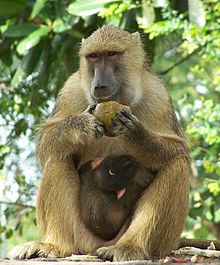Steppe baboon
| Steppe baboon | ||||||||||||
|---|---|---|---|---|---|---|---|---|---|---|---|---|

Steppe Baboon ( Papio cynocephalus ) |
||||||||||||
| Systematics | ||||||||||||
|
||||||||||||
| Scientific name | ||||||||||||
| Papio cynocephalus | ||||||||||||
| ( Linnaeus , 1758) |
The Yellow Baboon ( Papio cynocephalus ), also Yellow Baboon or Babuin called, is a primate of the genus baboons within the family of Cercopithecidae (Cercopithecidae).
features
Steppe baboons have a yellowish-brown fur , only the belly, the inside of the limbs and small spots next to the snout are whitish. The muzzle is black and hairless, as are the seat calluses. The tail is either held "kinked" as in other baboon species, that is, the first part stands up and the rear part hangs down, or it is gently curved. The body is relatively slim compared to other baboons, the arms and legs are long. At up to 25 kilograms, the males are significantly heavier than the females, who can only reach 12 kilograms. The canines of the males are also significantly larger.
distribution and habitat
Steppe baboons are common in large parts of eastern and southern Africa . Their distribution area extends from Somalia and Kenya to Tanzania and northern Mozambique and westwards to Angola and Zambia . Their habitat is not only steppes and savannahs , but also gallery forests .
Lifestyle and diet
Steppe baboons are diurnal and often stay on the ground, where they move with a four-footed gait. However, they can also climb well and mostly retreat to trees at night.
These animals live in large groups of 20 to 180 animals. They are mixed groups, that is, they include many males and females. Within the group, a distinctive hierarchy and complex social behavior is formed between both sexes (see group behavior of baboons ).
Steppe baboons are omnivores with a preference for fruits. In addition, however, they also consume other parts of plants such as roots and tubers as well as insects, eggs and small vertebrates (including small primate species).
Reproduction
The reproduction can take place all year round, the females show a pronounced normal swelling during the fertile phase . In principle, any male can mate with any female within the mixed groups. This leads to sometimes bitter disputes among the males about the mating privilege.
After a gestation period of around 180 days, the female usually gives birth to a single young. Newborns have black, reddish or white fur, and the adult coloring develops at six to nine months. After about a year, the young animal is weaned and sexually mature at five to seven years of age. Males have to leave their birth group at this point, while the females often remain in it for life.
In the wild these animals can live to be up to 27 years old, in captivity they can be older.
Steppe baboons and people
Although the loss of habitat and hunting pose threats to the steppe baboons in some places, overall the species is widespread and not endangered.
Systematics
The steppe baboon is one of the five species of the genus of the baboons ( Papio ), which are sometimes combined into a single species. A distinction is made between three subspecies, which differ among other things in the fur, the tail position and the color of the newborns:
- Papio cynocephalus cynocephalus lives mainly in Tanzania and northern Mozambique. Their tails are clearly kinked and the newborns' fur is black.
- P. c. ibeanus lives in Somalia and Kenya. This subspecies could be the product of the hybridization between steppe baboon and anubis baboon, which is common in this region .
- The Kindapavian ( P. c. Kindae ) is widespread from Angola to Zambia. This subspecies is characterized by the arched tail and the reddish color of the fur of the young. It is now considered a separate species.
Individual evidence
- ^ The modern animal lexicon , Volume 1, p. 177, Bertelsmann Lexikon Institut
- ^ Russell A. Mittermeier , Anthony B. Rylands & Don E. Wilson : Handbook of the Mammals of the World: Primates: 3rd page 661, ISBN 978-8496553897
literature
- Thomas Geissmann : Comparative Primatology. Springer-Verlag, Berlin et al. 2003, ISBN 3-540-43645-6 .
- Don E. Wilson, DeeAnn M. Reeder (Eds.): Mammal Species of the World. A taxonomic and geographic Reference. Johns Hopkins University Press, Baltimore MD 2005, ISBN 0-8018-8221-4 .
Web links
- Papio cynocephalus in the endangered Red List species the IUCN 2008 Posted by: J. Kingdon, T. M. Butynski, Y. De Jong, 2008. Accessed on January 1 of 2009.
- KA Cawthon Lang: Primate Factsheets: Yellow baboon ( Papio cynocephalus )
- Information at Animal Diversity Web



